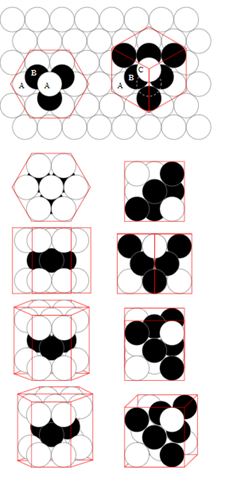In which of the following arrangements octahedral voids are formed?
In solids, the constituent particles are closely packed, leaving the minimum vacant space between them. They are called voids and they are shaped particularly in crystalline solids. Close packing in two dimensions can be of two types; square close-packed and hexagonal close-packed. Stacking of two dimensional layers one above the other creates three dimensional structures. When the second layer is placed over the first layer such that the spheres of the upper layer are exactly above those of the first layer, the arrangement generated is simple cubic lattice. A simple cubic has an atom at each corner of the cube. A body-centered cubic (bcc) unit cell has an atom at each of its corners and also one atom at its body center. In face centered cubic (fcc) the particles are arranged at the corners and also at the center of each of the faces. The formation of voids can be explained diagrammatically, where tetrahedral voids are formed when the sphere of the second layer is above void of first layer, a tetrahedral void is formed and in other places, the triangular voids in the second layer are above the triangular voids in the first layer, and the triangular shapes of these do not overlap. One of them has the apex of the triangle pointing upwards and the other downwards. These kind of voids surrounded by six spheres are octahedral voids. So according to the structures of the unit cells, option (ii) and (iii) cannot have octahedral voids.

1: Structures of hcp and fcc lattice formed after stacking of two dimensional sphere structures and top, side and bottom views of the same. Image obtained from Wikipedia under Creative Commons license. By en:User:Twisp - Own work, Public Domain.
Thus, hcp (hexagonal closed packing) and fcc (face-centred cubic cell) arrangements show the octahedral voids.
Thus, option (i), (ii) are the correct option.